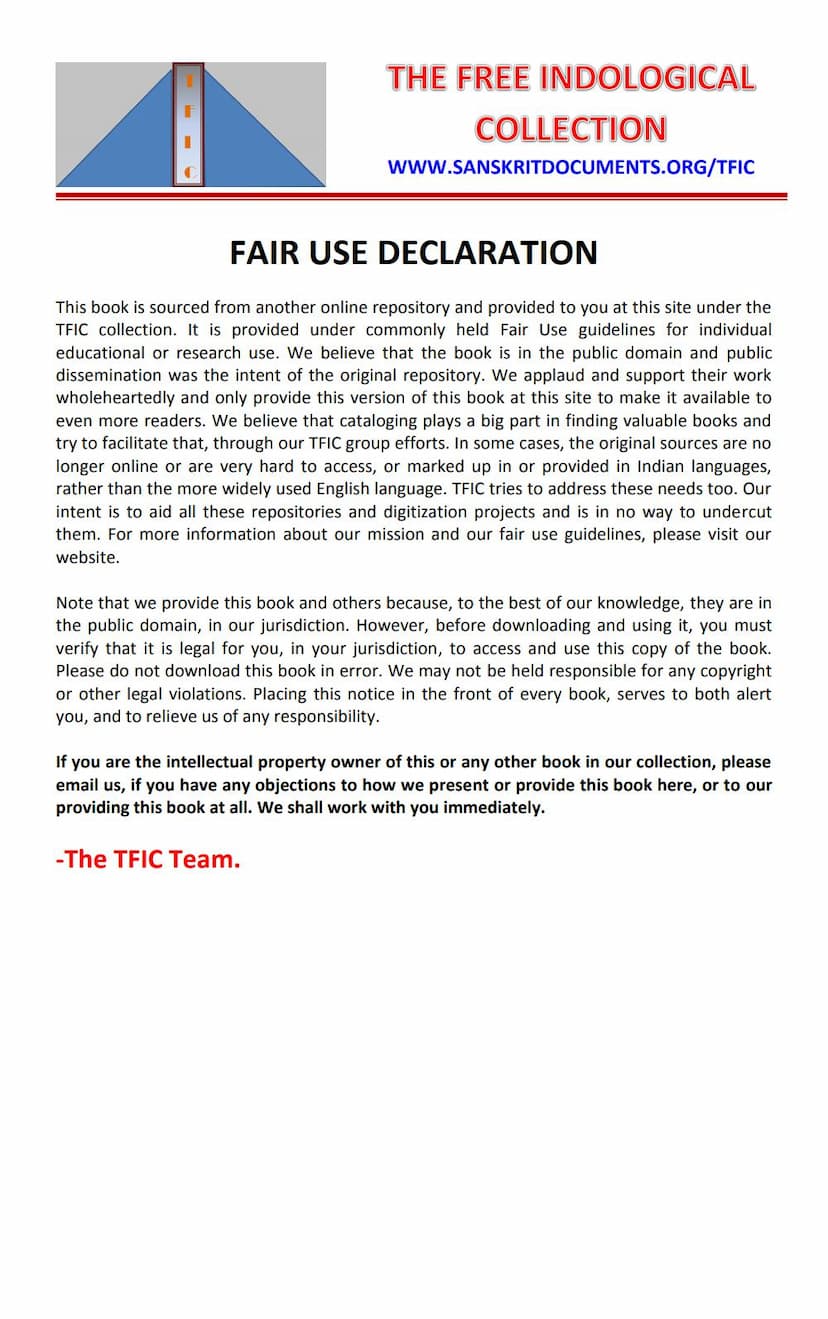Agam 01 Ang 01 Acharang Sutra Chintanika
Added to library: September 1, 2025

Summary
This book, "Agam 01 Ang 01 Acharang Sutra Chintanika," published by Labdhi Vikramsuri Sanskruti Kendra Ahmedabad, is a commentary and exploration of the Acharang Sutra, one of the foundational scriptures of Jainism. The text delves into various philosophical and practical aspects of Jain teachings, primarily focusing on the path to spiritual liberation (moksha) and the conduct of ascetics (sadhus and sadhvis).
Here's a breakdown of the key themes and concepts covered in the book, based on the provided pages:
Core Themes and Concepts:
- The Nature of Knowledge and Liberation: The book emphasizes that true omniscience (kevalgyan) is attained only after achieving the state of non-attachment (vitaragita). Knowledge that is not complete is not considered perfect, highlighting the Jain principle that detachment is the prerequisite for omniscience.
- The Role of Karma: The text discusses how attachment to worldly relationships (bahyasambandh) hinders spiritual progress. It identifies Mohaniya Karma (enchanting karma) as a significant obstacle to kevalgyan, as its removal is intrinsically linked to the removal of ignorance and illusion.
- The Importance of the Acharang Sutra: The Acharang Sutra is presented as the cornerstone of spiritual discipline and the primary guide for ascetics. It is considered the foundation for achieving a detached state and is essential for a complete spiritual life. The book acknowledges the challenges in fully accessing the original twelve Angas, but asserts that the existing Agamas, even in their fragmented form, are powerful enough to guide towards vitaragita.
- The Path of Vitaragita (Detachment): The central aim of Jain practice is to cultivate vitaragita, a state of non-attachment. This is achieved through the practice and contemplation of the teachings within the Agamas, particularly the Acharang Sutra.
- Chintanika (Contemplation/Reflection): The book itself is a "Chintanika," meaning it offers a reflective and analytical approach to the Acharang Sutra. It aims to help readers understand the profound meanings within the sutras and internalize them.
- The Role of the Guru: The book consistently highlights the indispensable role of the Guru in spiritual progress. The author, Sadhvi Ratnachulashriji, credits her Gurudev, Acharya Rajyash Surishwarji Maharaj Saheb, and her Dada Gurudev, Labdhisurishwarji Maharaj Saheb, for their blessings, inspiration, and guidance in this work. The Guru's teachings and insights are presented as crucial for overcoming obstacles and achieving spiritual goals.
- The Nature of the Self (Ahamkara/Mamta): The text stresses the need to shed ego (ahamkara) and possessiveness (mamata) to realize the true self (atma). It suggests that ego is a major impediment to spiritual growth and the attainment of divine grace.
- The Significance of "Suya Me": The opening words of the Acharang Sutra, "Suya Me" (I have heard), are analyzed extensively. They signify the importance of learning from a Guru, humility, and the transmission of knowledge. The author emphasizes that true knowledge is gained through respectful listening and diligent practice, not through ego-driven intellectualism.
- Discipline and Conduct: The Acharang Sutra, as interpreted in this book, lays down strict guidelines for the conduct of ascetics, covering aspects like the proper use of speech, the importance of vigilance, and the need for detachment from worldly desires. The text explores various sutras and their philosophical underpinnings, offering guidance on ethical behavior and spiritual practices.
- The Journey of Spiritual Growth: The book uses allegorical language and narrative examples to illustrate the challenges and rewards of the spiritual path. It encourages perseverance, self-reflection, and unwavering faith in the teachings and the Guru.
- The Nature of True Virtue: The commentary suggests that true virtue lies not just in outward actions but in inward purity of intention and detachment. The book contrasts worldly desires with spiritual aspirations, guiding the reader towards the latter.
- The Concept of "Vitaragta" (Non-Attachment): This is a recurring theme, emphasizing the release from worldly desires and attachments as the key to inner peace and spiritual realization.
Structure and Content:
The book is structured as a series of contemplative discussions on individual sutras of the Acharang Sutra. Each section begins with a sutra and then provides a detailed commentary and reflection on its meaning and application. The author frequently engages in a dialogue-like format with the reader (addressed as "Vats" or "Shishya"), anticipating questions and providing explanations.
Key Sutras Discussed (as indicated by the index):
The provided index lists numerous sutras from the Acharang Sutra that are analyzed, including:
- "Sura Me...evamakhya" (On the nature of self and hearing from the Guru)
- "Jae sadhaye nikhante tamev ashupalit" (On following the path with dedication)
- "Aura asse paritanti" (On the nature of suffering and its alleviation)
- "Pune pune gunsae vank samayare" (On repeated virtuous actions)
- "Je ajhajjham janai se bahia janai..." (On the interconnectedness of inner and outer knowledge)
- "Arambh satta pakati sang" (On attachment and its consequences)
- "Khana khana pandie" (On the wisdom of seizing opportunities)
- "Arai autte se mehani" (On overcoming delusion)
- "Manda mehana pauda" (On the impact of ignorance)
- "Vimutta hate jana je jana paragamine" (On the liberated and those who cross over)
- "Purisa tummeva tum mitt..." (On self-reliance and the true friend within)
- "Sahie dukhamtaye putto na zzajjae" (On enduring hardships with equanimity)
- "Pamattassa bhaya..." (On the fear of the heedless and the fearlessness of the vigilant)
- "Ne nihannij viriyam" (On not destroying one's strength)
- "Jaha pune kathai..." (On cause and effect)
- "Asi satya parenu pare" (On truth and its essence)
Overall Message:
The "Acharang Sutra Chintanika" serves as a devotional and insightful commentary on the Acharang Sutra, aiming to provide readers with a deeper understanding of Jain philosophy and practice. It emphasizes self-discipline, detachment, the importance of righteous conduct, and the guiding role of the Guru in the spiritual journey towards liberation. The book is a valuable resource for those seeking to deepen their understanding of Jainism and its ethical framework.